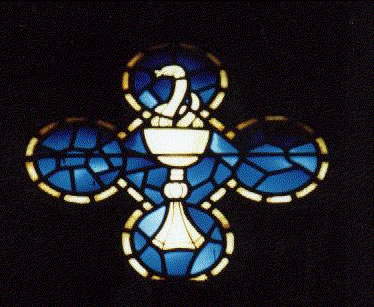
Clerestory Windows Series: John
One of the few, or perhaps the only, Apostle who did not die a horrible death. He died in exile on the Isle of Patmos. Tradition says that a priest of Diana gave John poisoned wine to drink, but he made the sign of the cross over the chalice, and the poison evaporated in the form of a serpent. That is the reason for the snake in a chalice on his window. John holds an honored place in Christian history. Hundreds of churches have been named for him, and many Christian leaders—including John Chrysostom, John Wycliffe, John Calvin, John Knox, and John Wesley—have borne his name. John was the son of Zebedee, and the brother of the apostle James. He was a fisherman by trade. Peter, John, and James formed the “inner circle of disciples. Some scholars believe that the disciple named John in the synoptic Gospels is the disciple “whom Jesus loved” in the fourth Gospel. John was one of the few, or perhaps the only, Apostle who did not die a horrible death. He died in exile on the Isle of Patmos. John appears to have been a man of great intolerance with a sometimes violent temper. He was a “hothead” whose solution to everything was to rebuke, or even worse, annihilate the opposition. He found a man casting out demons, and since the healer was not one of the disciples, John told him to stop. James and John even received a nickname, Boanerges, because of their outbursts. It means “sons of thunder.” When met by Samaritan opposition to Jesus’ passing through their village, John and his brother’s solution to the problem was to call down fire to kill the opposition. John wasn’t all that different from most people. How many of us respond to opposition with anger? When people disagree, it is often a result. Just look at the anger surrounding issues such as civil rights and abortion. People on both sides of these issues would gladly call down fire to blot out the opposition. Even within our own denomination, we’ve had great fights and splits. From the issue of slavery to the issue of the ordination of women, factions within our church family have become so angry with each other that they can no longer worship together. Anger and intolerance have existed since the beginning of human existence, and will likely be with us until the kingdom is fulfilled. The good news is that Jesus took John as he found him—brash, intolerant, and angry—and guided him to be able to use these characteristics in a positive way. Anger and intolerance are morally neutral. Anger against our fellow brothers and sisters is bad, but it is good to be angry that people in this world are hungry; it is good to be intolerant of disease, oppression, social injustice, hate, fear, and ignorance. Jesus showed John that it is possible to fight against injustice without hating or wanting to destroy the people with an opposing view. The good news of John is the same good news shared through the stories of so many of the disciples. Jesus can take an imperfect human and despite his or her flaws, teach them how to serve God. None are beyond redemption. Whether we suffer from doubt, disbelief, fear, ignorance or anger, the love and grace of God show in Christ Jesus can teach us and transform us. How could we even hope for anything more than that? Brandon Gilliam
|
 Questions, comments, or broken links? Please email the webmaster at bgilliam@bgilliam.com
Questions, comments, or broken links? Please email the webmaster at bgilliam@bgilliam.com
Unless otherwise stated, all material contained in this web site is Copyright © 2015 by Brandon Gilliam.







